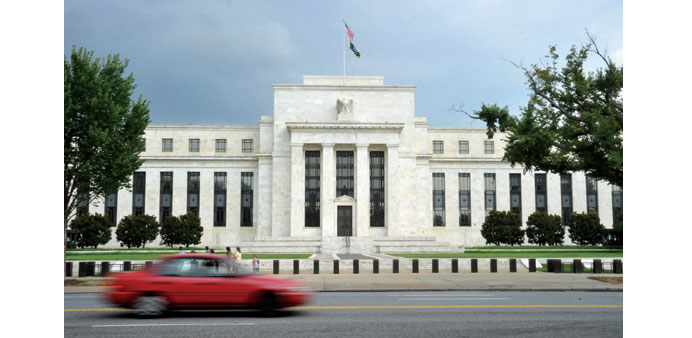The US Federal Reserve building is seen in Washington. The Wall Street’s consensus is that the Fed will lift its target by a quarter-percentage point to a range of 0.25% to 0.5%.
Bloomberg
New York
The greatest monetary-easing cycle in the history of the US has left a mind-boggling amount of cash floating around in the economy. Banks hold $2.5tn in excess reserves - money they essentially don’t know what to do with - at the Federal Reserve.
So as the Fed prepares to raise interest rates from near zero as soon as next week, bond investors are on edge. Beyond all the “is-this-the-right-move” questions that surround every increase, there’s a logistical concern: With so much cash sloshing around, will Fed officials be able to nudge rates as high as they want? Will the new-fangled tools they’ve created to engineer the move work, or instead sow the kind of confusion that can dent the Fed’s credibility and spur a broader market selloff?
Many investors are taking no chances. They’re piling into the safest, most liquid securities available, or those that move them as far away from the epicentre of the US financial system as possible. James Camp at Eagle Asset Management is buying Treasuries and unloading debt linked to credit, such as corporate bonds. Peter Yi, director of short-term fixed income at Northern Trust Corp is stockpiling cash. Jerome Schneider, head of short-term strategies at Pacific Investment Management Co, is diversifying into securities such as debt in foreign currencies. In a sign of the search for liquidity, US money funds have cut the average maturity of their assets to the lowest since 2006.
“You just stay away from this one,” said Camp, director of fixed-income at Eagle Asset, which manages $30.6bn in St Petersburg, Florida. “You just let this play out. It’s OK to wait and see, and see how risk markets react. I love Treasuries here.”
In the lead-up to the Fed decision, investors are the most bullish on Treasuries since 2013, according to a JPMorgan Chase & Co survey of clients on Monday. A rout last week that drove two-year yields to a five-year high helped lure buyers anticipating that the Fed will stick to a gradual pace of rate increases. Wall Street’s consensus is that the Fed will lift its target by a quarter-percentage point on December 16, to a range of 0.25% to 0.5%.
Camp boosted Treasuries holdings by 20% in the last six months, most recently adding seven- to 10-year maturities. He sees government debt offering shelter in case the Fed’s tightening leads investors to shun riskier assets, such as high- yield securities, and prefers longer maturities that would be less influenced by turbulence in shorter-dated obligations.
Yi at Chicago-based Northern Trust, which manages $946bn, has cash and securities maturing within five days as much as 15% above levels of prior years in the short-term funds he oversees. He’s focused on boosting holdings that are easy to sell in the event he faces withdrawals.
“We need to be prudent about any interest-rate exposure,” said Pimco’s Schneider, who manages about $250bn of short- term assets at the Newport Beach, California-based firm. “We’re looking for ways to diversify our liquidity risk in high-quality assets, and doing so with the view that rates are going higher.”
At issue is the Fed’s balance sheet, which ballooned as it bought bonds to pump cash into the economy and support faltering growth. Policy makers need new methods to drain that money and push rates higher in an interbank lending market, known as fed funds, that has become harder to influence now that cash-heavy banks rely on it infrequently. Some investors see the volatility around the Fed liftoff as a temporary disturbance with a limited ripple effect during the year-end period.
“Any noise that comes about related to the mechanics of the rate rise is likely to be in the very, very front-end and for a short period of time,” said Brett Wander, chief investment officer for fixed income in San Francisco at Charles Schwab Investment Management, which oversees $267bn.
Yet others are watching how the Fed handles the mechanics of the move. Camp at Eagle Asset and strategists at TD Securities say policy makers will need to more than triple the size of its daily reverse-repo program - where they drain money from the financial system by temporarily lending out securities - to at least $1tn. Expanding the program, which officials began in September 2013, would help anchor the fed funds rate. Yet the Fed may baulk at the move because officials have signaled they’re wary of playing too big a role in money markets.
In previous tightening cycles, there were less reserves sloshing around in the financial system. That made it a lot easier for policy makers to hit their desired rate.
In the coming exit, the Fed hopes to keep the fed funds effective rate - the average for money-market trades - in a range, rather than at a specific level. The peak of the band is set by the interest rate the Fed pays banks on excess reserves, while the bottom comes from its reverse-repo rate.



